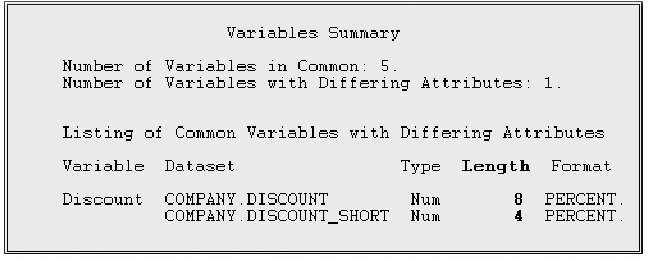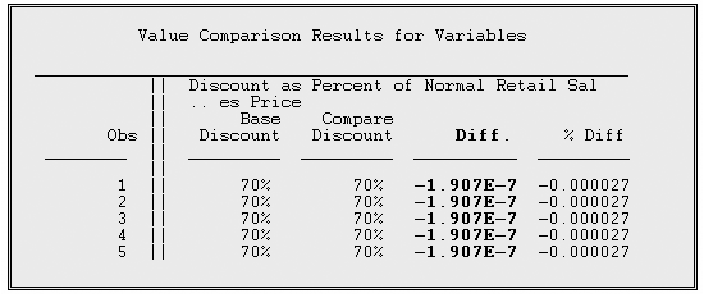Reducing Data Storage Space for Numeric Variables
Another
way to reduce data storage space is to reduce the length of numeric
variables. In addition to conserving data storage space, reduced-length
numeric variables use less I/O, both when data is written and when
it is read. For a file that is read frequently, this savings can be
significant. However, in order to safely reduce the length of numeric
variables, you need to understand how SAS stores numeric data.
How SAS Stores Numeric Variables
To
store numbers of large magnitude and to perform computations that
require many digits of precision to the right of the decimal point,
SAS stores all numeric values using double-precision floating-point
representation. SAS numeric variables have a maximum length of 8 bytes
and a minimum length of 2 or 3 bytes, depending on your operating
environment. The default length is 8 bytes. Multiple digits are stored
per byte.
Floating-point representation
is an implementation of scientific notation. For example, the number
234 might be written as .234*10**3 with a base of 10. In this example,
.234 is referred to as the mantissa, 10 is the base, and 3 is the
exponent. The figures below show how SAS stores a numeric value in
8 bytes. Mainframe environments use base 16. The first bit stores
the sign, the next seven bits store the exponent, and the remaining
56 bits store the mantissa.
Non-mainframe environments
use base 2. The first bit stores the sign, the next 11 bits store
the exponent, and the remaining 52 bits store the mantissa.
Note: The minimum length for a
numeric variable is 2 bytes in mainframe environments and 3 bytes
in non-mainframe environments.
Now that you have seen
how SAS stores numeric variables, consider how you can assign a length
to your numeric variables that is less than the default length of
8 bytes.
Assigning Lengths to Numeric Variables
You can use a LENGTH statement to assign a length from
2 to 8 bytes to numeric variables. Remember, the minimum length of
numeric variables depends on the operating environment. Also, keep
in mind that the LENGTH statement affects the length of a numeric
variable only in the output data set. Numeric variables always have
a length of 8 bytes in the program data vector and during processing.
|
General form, LENGTH
statement for numeric variables:
LENGTH variable(s)
length <DEFAULT=n>;
variable(s)
specifies the name
of one or more numeric SAS variables, separated by spaces.
length
is an integer that
specifies the length of the variable(s).
DEFAULT=n
this
optional argument changes the default number of bytes that SAS uses
to store any newly created numeric variables. If you use the DEFAULT=
argument, you do not need to list any variables.
|
DEFAULT=
applies only to numeric variables that are created after the LENGTH
statement. List specific variables, and their lengths, along with
the DEFAULT= argument, if you want the listed variables to receive
a specified length. Then the non-listed variables receive the DEFAULT=
length.
CAUTION:
Numeric
values lose precision if truncated. You learn more about the loss
of precision with reduced-length numeric variables in the next section
of this chapter.
Example
The
following program assigns a length of 4 to the new variable Sale_Percent
in the data set ReducedSales. The LENGTH statement in this DATA step
does not apply to the variables that are read from the Sales data
set; those variables maintain whatever length they had in Sales when
they are read into ReducedSales.
data reducedsales; length default=4; set sales; Sale_Percent=15; run;
Maintaining Precision in Reduced-Length Numeric Variables
There is a limit to the values that you can precisely
store in a reduced-length numeric variable. You have learned that
reducing the number of bytes that are used for storing a numeric variable
does not affect how the numbers are stored in the program data vector.
Instead, specifying a value of less than 8 in the LENGTH statement
causes the number to be truncated to the specified length when the
value is written to the SAS data set.
You should never use
the LENGTH statement to reduce the length of your numeric variables
if the values are not integers. Fractional numbers lose precision
if truncated. Even if the values are integers, you should keep in
mind that reducing the length of a numeric variable limits the integer
values that can accurately be stored as a value.
The following table
lists the possible storage length for integer values on UNIX or Windows
operating environments.
|
Length (bytes)
|
Largest Integer Represented
Exactly
|
|---|---|
|
3
|
8,192
|
|
4
|
2,097,152
|
|
5
|
536,870,912
|
|
6
|
137,438,953,472
|
|
7
|
35,184,372,088,832
|
|
8
|
9,007,199,254,740,992
|
The following table
lists the possible storage length for integer values on the z/OS operating
environment.
|
Length (bytes)
|
Largest Integer Represented
Exactly
|
|---|---|
|
2
|
256
|
|
3
|
65,536
|
|
4
|
16,777,216
|
|
5
|
4,294,967,296
|
|
6
|
1,099,511,627,776
|
|
7
|
281,474,946,710,656
|
|
8
|
72,057,594,037,927,936
|
Suppose you store an
integer that is equal to or less than the number listed above as the
largest integer that can be represented exactly in a reduced-length
variable. In such a case, SAS truncates bytes that contain only zeros.
If the integer that is stored in a reduced-length variable is larger
than the recommended limit, SAS truncates bytes that contain numbers
other than zero, and the integer value is changed. Similarly, you
should not reduce the stored size of non-integer data because it can
result in a loss of precision due to the truncation of nonzero bytes.
If you decide to reduce
the length of your numeric variables, you might want to verify that
you have not lost any precision in your values. Here is one way to
do this action.
Using PROC COMPARE
You can use PROC COMPARE to gauge the precision of the
values that are stored in a shortened numeric variable. You do this
by comparing the original variable with the shortened variable. The
COMPARE procedure compares the contents of two SAS data sets, selected
variables in different data sets, or variables within the same data
set.
|
General form, PROC COMPARE
step to compare two data sets:
PROC COMPARE BASE=SAS-data-set-one
COMPARE=SAS-data-set-two;
RUN;
SAS-data-set-one and SAS-data-set-two
specifies the two SAS
data sets that you want to compare.
|
PROC
COMPARE is a good technique to use for gauging the loss of precision
in shortened numeric variables because it shows you whether there
are differences in the stored numeric values even if these differences
do not appear once the numeric variables have been formatted. PROC
COMPARE looks at the two data sets and compares the following:
-
data set attributes
-
variable attributes for matching variables
-
observations
-
values in matching variables
Output from the COMPARE
procedure includes the following information:
-
a data set summary
-
a variables summary
-
a listing of common variables that have different attributes
-
an observation summary
-
a values comparison summary
-
a listing of variables that have unequal values
-
a detailed list of value comparison results for variables
Example
The data set Company.Discount
contains data about sale dates and discounts for certain retail products.
There are 35 observations in Company.Discount, which is described
below.
|
Variable
|
Type
|
Length
|
Description
|
|---|---|---|---|
|
Product_ID
|
num
|
8
|
product ID number
|
|
Start_Date
|
num
|
4
|
start date of sale
|
|
End_Date
|
num
|
5
|
end date of sale
|
|
Unit_Sales_Price
|
num
|
8
|
discounted sales price
per unit
|
|
Discount
|
num
|
8
|
discount as percent
of normal sales price
|
Suppose you shorten
the length of the numeric variable Discount. The DATA step below creates
a new data set named Company.Discount_Short, whose only difference
from Company.Discount is that the length of the variable Discount
is 4 instead of 8.
data company.discount_short; length Discount 4; set Company.Discount; run;
You can use PROC COMPARE
to evaluate whether shortening the length of Discount affects the
precision of its values by comparing Company.Discount to Company.Discount_Short.
proc compare base=company.discount
compare=company.discount_short;
run;If you were to print
these two data sets (Company.Discount and Company.Discount_Short),
the values might appear to be identical. However, there are differences
in the values as they are stored, but those differences are not apparent
in the formatted output.
In the partial output
below, you can see that shortening the length of Discount results
in a loss of precision in its values; the values for Discount in Company.Discount_Short
differ by a maximum of 1.9073E-07. The value comparison results show
that although the values for Discount in the first five observations
appear as 70% in both data sets, the precise (unformatted) values
differ by −1.907E-7.
Comparative Example: Creating a SAS Data Set That Contains Reduced-Length Numeric Variables
Default versus Reduced-Length Numeric Variables
Suppose you want to
create a SAS data set to store retail data about a group of orders.
Suppose that the data that you want to include in your data set is
all numeric data and that it is currently stored in a raw data file.
The following sample
programs compare two techniques. You can use these samples as models
for creating benchmark programs in your own environment. Your results
might vary depending on the structure of your data, your operating
environment, and the resources that are available at your site.
Note: Throughout
this book, the keyword _NULL_ is often used in place of the data set
name in sample programs. Using _NULL_ suppresses the creation of an
output data set. Using _NULL_ when benchmarking enables you to determine
what resources are used to read a SAS data set.
Programming Techniques
|
This program reads the
external data file that is referenced by the fileref Flat1 and creates
a new data set called Retail.Longnums that contains 12 numeric variables.
Each of the variables in Retail.Longnums has the default storage length
of 8 bytes. The second DATA step in this program reads the numeric
variables from Retail.Longnums.
data retail.longnums;
infile flat1;
input Customer_ID 12.
Employee_ID 12.
Street_ID 12.
Order_Date date9.
Delivery_Date date9.
Order_ID 12.
Order_Type comma16.
Product_ID 12.
Quantity 4.
Total_Retail_Price dollar13.2
CostPrice_Per_Unit dollar13.2
Discount 5. ;
run;
data _null_;
set retail.longnums;
run; |
|
This program reads the
external data file that is referenced by the fileref Flat1 and creates
a new SAS data set called Retail.Shortnums that contains 12 numeric
variables. A LENGTH statement is used to reduce the storage length
of most of the numeric variables in Retail.Shortnums, as follows:
The second DATA step
reads the reduced-length numeric variables from Retail.Shortnums.
data retail.shortnums;
infile flat1;
length Quantity Order_Type 3
Customer_ID Order_Date
Delivery_Date Discount 4
Employee_ID 5
Street_ID Order_ID 6
Product_ID 7
Total_Retail_Price
CostPrice_Per_Unit 8;
input Customer_ID 12.
Employee_ID 12.
Street_ID 12.
Order_Date date9.
Delivery_Date date9.
Order_ID 12.
Order_Type comma16.
Product_ID 12.
Quantity 4.
Total_Retail_Price dollar13.2
CostPrice_Per_Unit dollar13.2
Discount 5. ;
run;
data _null_;
set retail.shortnums;
run; |
Note: Remember that when you reduce
the storage length of numeric variables, you risk losing precision
in their values. You can use PROC COMPARE to verify the precision
of shortened numeric variables.
proc compare base=retail.longnums;
compare=retail.shortnums;
run;..................Content has been hidden....................
You can't read the all page of ebook, please click here login for view all page.





